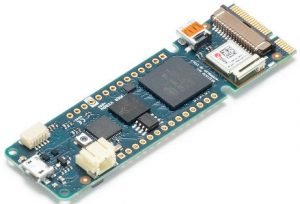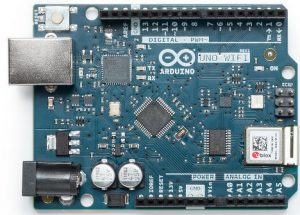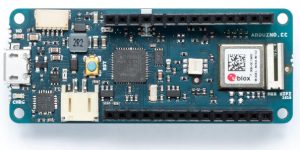
News
Updated: Arduino announces FPGA board, ATmega4809 in Uno Wi-Fi mk2, cloud-based IDE and IoT hardware

FPGA
MKR Vidor 4000 is the first-ever Arduino board featuring an FPGA chip – an Intel/Altera MAX10 – plus an ARm Cortex-M0+ based MCU (SAMD21) and U-blox Nina W102-00B Wi-Fi connectivity. Also on-board is secured for network and Internet connections through an ECC508 crypto-chip.
MKR (pronounced ‘maker’) is the 25 x 75mm family of boards, with a whole host of wireless interface choice, aimed developing IoT products.
“The MKR Vidor 4000 will finally make FPGA accessible to makers and innovators,” said Arduino co-founder Massimo Banzi, who told Electronics Weekly that additions to the Arduino IDE would allow pre-configured FPGA code to be installed, and that a new internet-based development environment would allow drag-and-drop FPGA configuration. “People will not need to know anything about the underlying Verilog,” he said.

Uno WiFi Rev 2, and ATmega4809
Distantly-related to the discontinued Arduino Uno Wi-Fi, ‘Uno Wi-Fi Rev 2’, is a new Arduino in the classic Uno shape, co-developed with Microchip and featuring the ATmega4809 for the first time – the adoption of which was predicted by Electronics Weekly in March. Wi-Fi comes from a U-blox Nina W102-00B WiFi module.
“The new board aims at making it even easier to deploy products that need connectivity. The new microcontroller provides: 6kbyte of RAM, 48kbyte of Flash, 3 UARTS, core independent peripherals and a high speed ADC,” according to Arduino – ‘core independent peripheral’ is Microchip branding for peripherals that can work and interact while the processing core sleeps.
However, “it will not replace the Uno”, Arduino CEO Fabio Violante told Electronics Weekly.
Arduino IDE and The Cloud
Arduino IDE, the Windows/Linux/Mac based development environment for ‘sketches’ (Arduino programs) will be updated considerably this year.
“We are investing a lot of money in the next few moths for a complete revamp of Arduino IDE,” co-founder Banzi told Electronics Weekly. “It will be will be Arduino IDE v2.0 by the end of the year – a lot more professional, and it will will have a debugger.”
v2.0 will be a bridge between the classic IDE and the forthcoming cloud-based IDE, possibly called Create IDE, which will include the FPGA programming facility.
According to Banzi, licensing and the huge processing requirement means FPGA programming will not be available in the downloadable version of Arduino IDE.
What the downloadable version will get, is a command line interface.
“You will be able to do anything Arduino can do in the command line – proper Arduino, not sub-par Arduino,” said Banzi. “If want to use Open Studio or Eclipse with the command line, will work. It will be a very thin, very quick, command line tool.”

Professional users, and IoT
The range of MKR boards is going to be expanded, and there will be carrier boards in which to plug them, and other interface boards to plug on top, with the intention that SME can develop and deploy products by mixing and matching suitable processing, sensor interfaces and pre-certified wireless interfaces.
“They can combine ingredients for infinite number of combinations,” said Banzi, who sees MKR board suiting SMEs shipping hundred or even thousands of units.
Those shipping more, perhaps millions, of units will want to spin their own PCBs, and may not want to include open-source Arduino intellectual property because that can allow competitors to copy what would otherwise be a proprietary design.
For these companies, said Banzi, Arduino is going to create a licencing model that will release selected Arduino intellectual property in non-open-source form for inclusion into proprietary products.